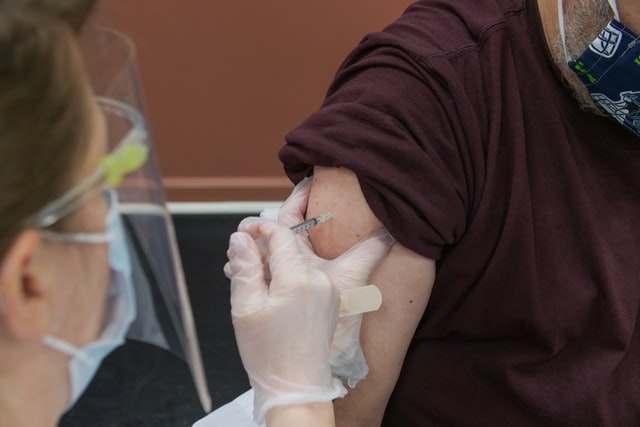Vaccine definition meaning. The vaccine is essential to get rid of different viral diseases, but there is confusion and misunderstanding about vaccines among people. here we will explain the vaccine in biological and medical terms to make you understand the actual definition of vaccine.

Medical
A Vaccine is a preparation that stimulates the immune system of a body in fighting with foreign bodies entering and damaging the body. After the Vaccine stimulates the immune reaction, The B Cells are sensitized and respond to the foreign agent entering the body. The vaccine also stimulates passive immunity by stimulating antibodies or lymphocytes. Vaccines are mostly given through injection.
Vaccines are also applied to mucosal surfaces like the gut or nasal mucous, and they aid in triggering an antibody response, which helps fight many germs entering the body.
Vaccines generally comprise dead or inactivated bacteria or purified products that are derived from them. There are a variety of vaccines that are in use. There are various methods used to decrease the chance of getting sick and still stimulate a healthy immune response. The subset that comprises genetic vaccinations comprises DNA vaccines, viruses, and RNA vaccines.
Cholera vaccine
A vaccine made from dead or inactivated Vibrio Cholerae is known as the cholera vaccine.
DNA vaccine
A vaccine created by genetic engineering where the gene encodes an antigen is introduced inside a bacterial plasmid later injected into the recipient’s body. Once within the human body, use the nuclear machinery in the cell of the host to produce and release the antigen.
Contrary to other vaccines, DNA vaccines could be able to trigger cellular and also humoral immune reactions.
DTaP vaccine
A combination of diphtheria and tetanus-related toxoids as well as acellular per proteins. It’s used to protect children against the three infections and adults at high risk of complications from infection by pertussis.
DPT vaccine
A stale combination of tetanus and diphtheria toxoids and pertussis bacilli have been killed. However, it’s no longer used as a part of immunizations for children due to the advantages of DTaP, which has only acellular pertussis.
Diphtheria vaccine
A vaccination against Corynebacterium diphtheriae
Conjugate vaccine
A vaccine is derived from an antigen from a virus or bacterium connected to an immunologically active molecule. This increases the chance that the person who receives the vaccine will develop antibodies to the main goal of the vaccination.
HPV vaccine
A vaccine that helps protect against various forms of human papillomavirus infections, particularly those related to cervical cancer and genital warts.
Human diploid cell rabies vaccine
HDCV is a vaccine that is derived from the rabies virus fixed and that is cultivated in human diploid cell culture.
Inactivated poliovirus vaccine
Poliovirus vaccine inactivated an injectable vaccine-derived out of three kinds of polioviruses that are inactivated. The first effective vaccine for poliomyelitis. It is the sole vaccination against polio across the U.S.
Dendritic cell vaccine
A cancer-fighting vaccine is created by taking dendritic (antigen-presenting) cells from cancer patients and stimulating them to reproduce and then exposing them to antigens extracted from the cancer of the patient.
Dendritic cells exposed to antigens are then injected into the cancer patient.
Biology
A Vaccine is a special preparation that contains the killed or weak form of a disease-causing agent, its toxins, or its surface proteins, and when injected inside the body, it leads to the formation of antibodies that provide immunity against that specific organism.
And the body remembers this exposure as a threat and stays prepared if this exposure occurs again.
This process of administration of the vaccine is named vaccination. This is because it has eradicated many contagious diseases and pandemics from the world, like chickenpox and smallpox. The word vaccine is derived from the Latin word “vaccines,” from “Vacca,” which means from cows.
The idea behind vaccinations is to activate an immune memory response without actually causing disease. If this occurs, it gives you immunity, but without the risk of getting sick. Therefore, the vaccine should contain the least amount of antigen that comes from the virus or bacteria to trigger an immune response.
There are many ways in which an antigen could be employed
Attenuated live virus–weakened forms of live viruses. They don’t cause illness, but they trigger some kind of immune reaction. Some examples include MMR (measles Mumps, measles-rubella) and chickenpox vaccines.
Inactivated viruses: A type of virus that has been destroyed. Even though the virus is gone, antibodies will continue to be created. Some examples include the Polio vaccine.
Recombinant–Viruses are produced in the laboratory through genetic engineering. This is how a specific gene can be replicated. For example, human papillomavirus (HPV) includes a variety of varieties. It is possible to get the HPV vaccination can be customized to guard
Conjugate vaccine
Virus and bacteria antigens could be coated with polysaccharide that is a sugar-like substance in order to help protect it. Then, conjugate vaccines work to get around the disguise to detect the bacteria. Hib is one example. Hib vaccination is one example of the conjugate.
Read also in the blog: Ontology in medicine and nursing; How many massages can we perform before giving mouth-to-mouth resuscitation?.
Other resources: InmunizeBC; Wikipedia
This post is also available in:
![]() English
English ![]() Français (French)
Français (French) ![]() Deutsch (German)
Deutsch (German) ![]() Dansk (Danish)
Dansk (Danish) ![]() Nederlands (Dutch)
Nederlands (Dutch) ![]() Svenska (Swedish)
Svenska (Swedish) ![]() Italiano (Italian)
Italiano (Italian) ![]() Português (Portuguese (Portugal))
Português (Portuguese (Portugal))